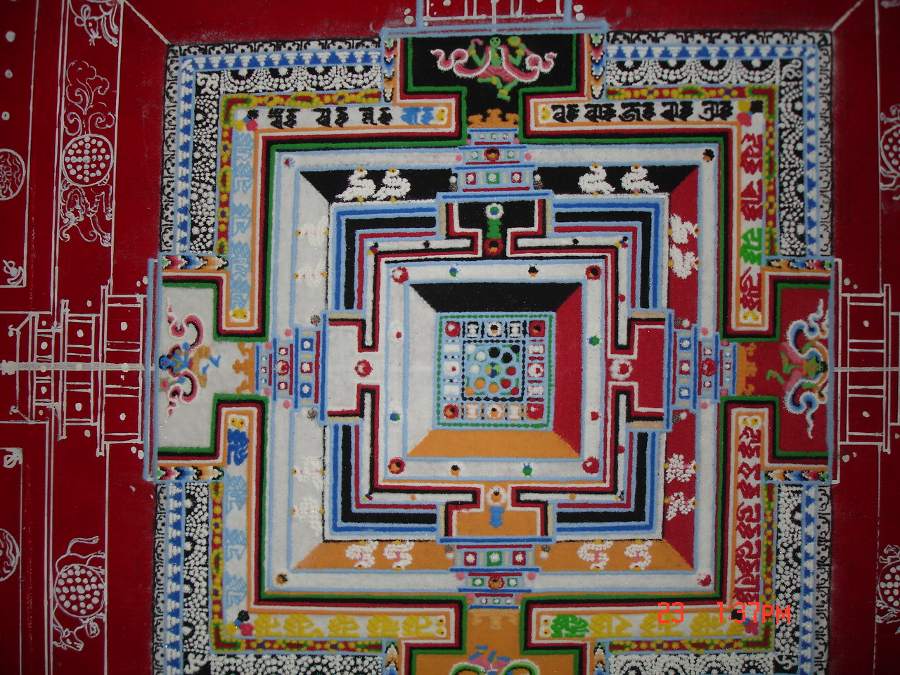Kalachakra Mandala
The word Kalachakra means “Cycle of Time”. The Kalachakra Tantra is a profound Buddhist system of teaching and practice which encompasses three aspects:
Centre of Kalachakra Mandala
- Outer Kalachakra: the external environment, the universe and its cycles of arising and disintegrating. Our world system and its cycles of sun, living in the universe, and the cycle of death and birth and internal flows of breath and energy.
- Inner Kalachakra: the sentient beings living in the universe, and the cycles of death and birth and internal flows of breath and energy;
- Alternative Kalachakra: The practice of purification undertaken by an individual so that ordinary death, birth, and manifestation on both an individual and universal level, which are usually uncontrollably subject to the passage of time, become purified into the fully Enlightened state of complete Buddhahood.
The Kalachakra Tantra has particular relevance for our world system. The Tantra was taught by the Buddha in India two and half thousand years ago at the request of the King of Shambala, a place variously viewed as is having been an actual historical kingdom which existed beyond the Himalaya, or as a pure land existing on another planet not generally accessible but nonetheless strongly connected to our world. Predictions concerning Shambala have particular relevance to world events of today, being especially concerned with peace on this planet, and can also be compared with the predictive literature of other religions.
All Buddhist teachings are based on the Four Noble Truths: the recognition that every sentient being experiences suffering; the understanding of the causes of this suffering; the recognition that if the causes are removed there will be an end to the suffering; and the practical methods by which to achieve Liberation from suffering, or full Enlightenment or Buddhahood.
Within the Buddhist Tantras, the practice of Highest Yoga Tantra leads to perfect Buddhahood. The Kalachakra Tantra is a Highest Yoga Tantra, and as such can be said to epitomize the apex of Buddhist Teachings. Only in Tibet were the Highest Yoga Tantras preserved and practiced as a living tradition after the decline of Buddhism in its native land of India.
Description of the Kalachakra mandala
The Mandala, as represented here in particles of coloured sand, is the residence of the Kalachakra deity and the retinue of deities surrounding him, all of which represent the components of a single individual person in purified form-a fully enlightened being.
Although depicted here on a flat surface, the mandala is actually three-dimensional, being a five-storied divine mansion, at the centre of which stands the Kalachakra deity, the manifest state of Enlightenment.
The sand mandala can be thought of as a plan of Kalachakra’s residence or pure environment. It represents a large building or palace, standing on a raised foundation, with four walls with a door in the centre of each; there is a roof over the whole building. The five stories of the palace represent the five levels of body, speech, mind, pristine consciousness, and great bliss. The colours of the four directions correspond with the colours of the four faces of Kalachakra; black in front, red to the right, white to his left and yellow at the back. The palace is surrounded bye various articles of offerings, and is resting on yellow, white, red and grey-blue discs which represent the four elements of earth, water, fire and wind. There are eight great cemeteries represented as wheels between the fire and wind perimeters; the other two wheels depict cemeteries above and below. There is a setting sun and a rising moon on the earth perimeter. The whole is surrounded by a protective fence of Vajras, and outside it is blazing light.
The meditation
One can imagine entering the Mandala through one of the outer doors at the first level, which of the body mandala, walking in through the outer walls, which are transparent and in five layers and coloured, from outside to inside, yellow, white, red, black and green. You walk further in and climb up the each steps to the second level, the speech of Mandala, also surrounded by five transparent coloured walls; up another set of steps to the third level, the mind mandala, surrounded by three transparent coloured walls. You can see inside the mind mandala a square platform, the fourth level, the pristine consciousness mandala. On this platform is another platform, the fifth level, the great bliss mandala where the main Kalachakra deity stands on an eight-petalled lotus.
A representation of this mandala is used by a practitioner of the Kalachakra Tantra for the purpose of visualizing in meditation. The every aspect of the Mandala has meaning, nothing is superfluous or arbitrary. As part of his or her training, a practitioner develops the power of meditative concentration to be able to visualize not only every details of the mandala, but also of the deities present within it.
Just to glimpse this sand mandala, however is thought establish a positive connection with this profound Buddhist Tantra, and to sow positive seeds upon the mind stream of the observer which will ripen beneficially in the future as the events of our world system manifest as predicted in the Kalachakra teachings.

